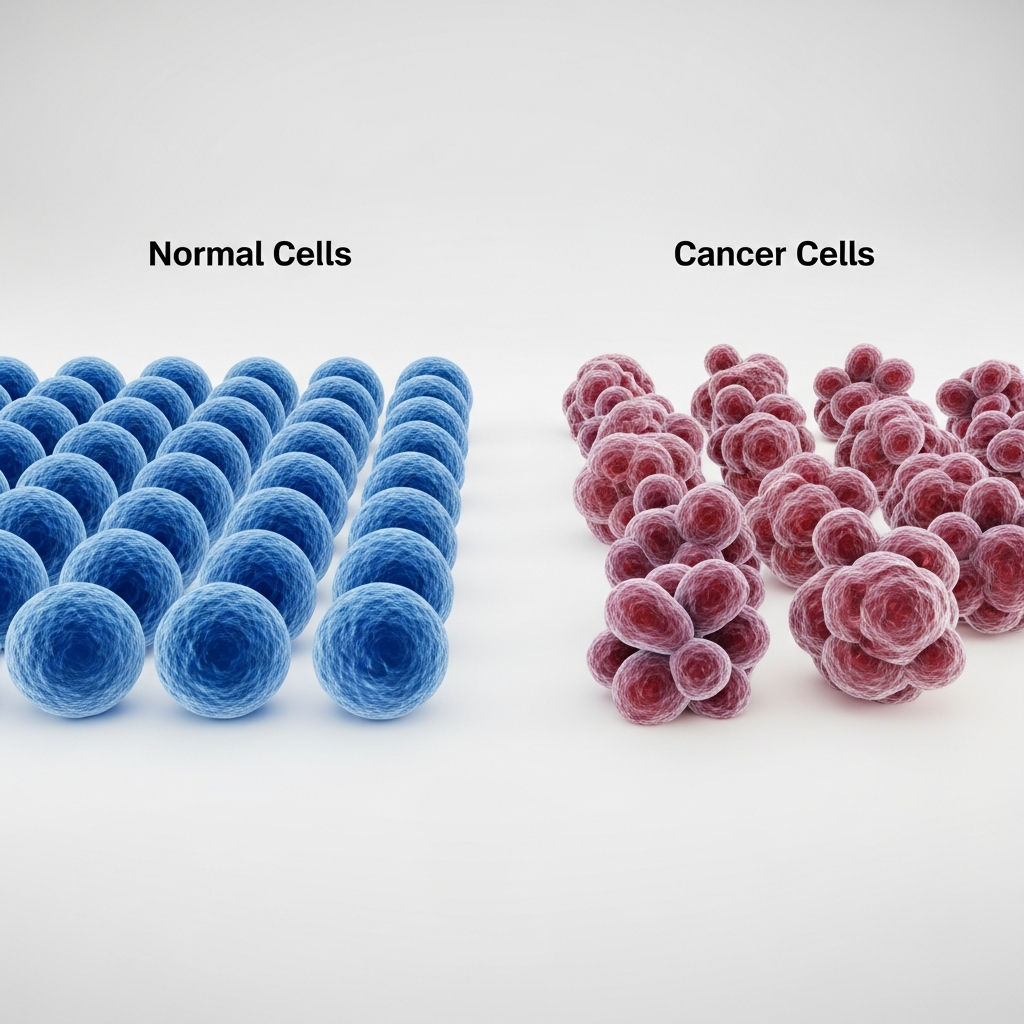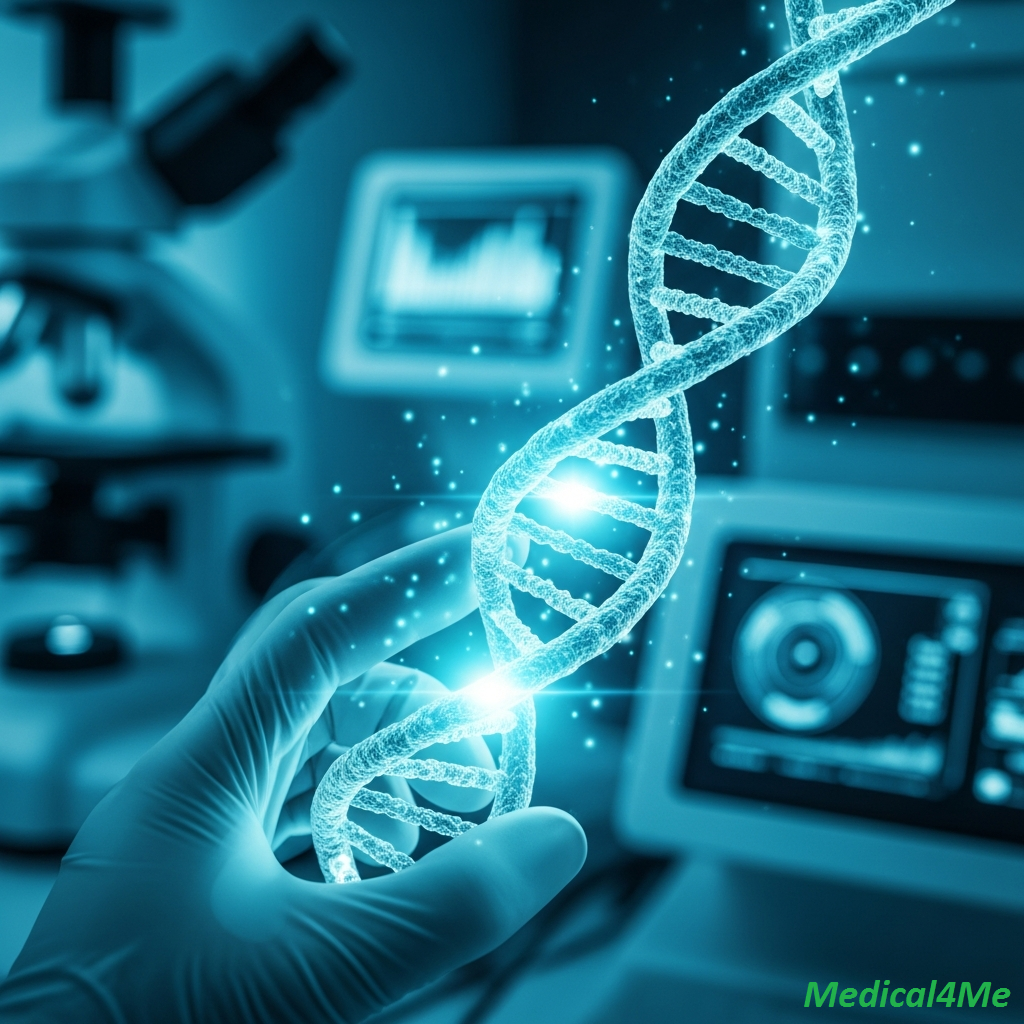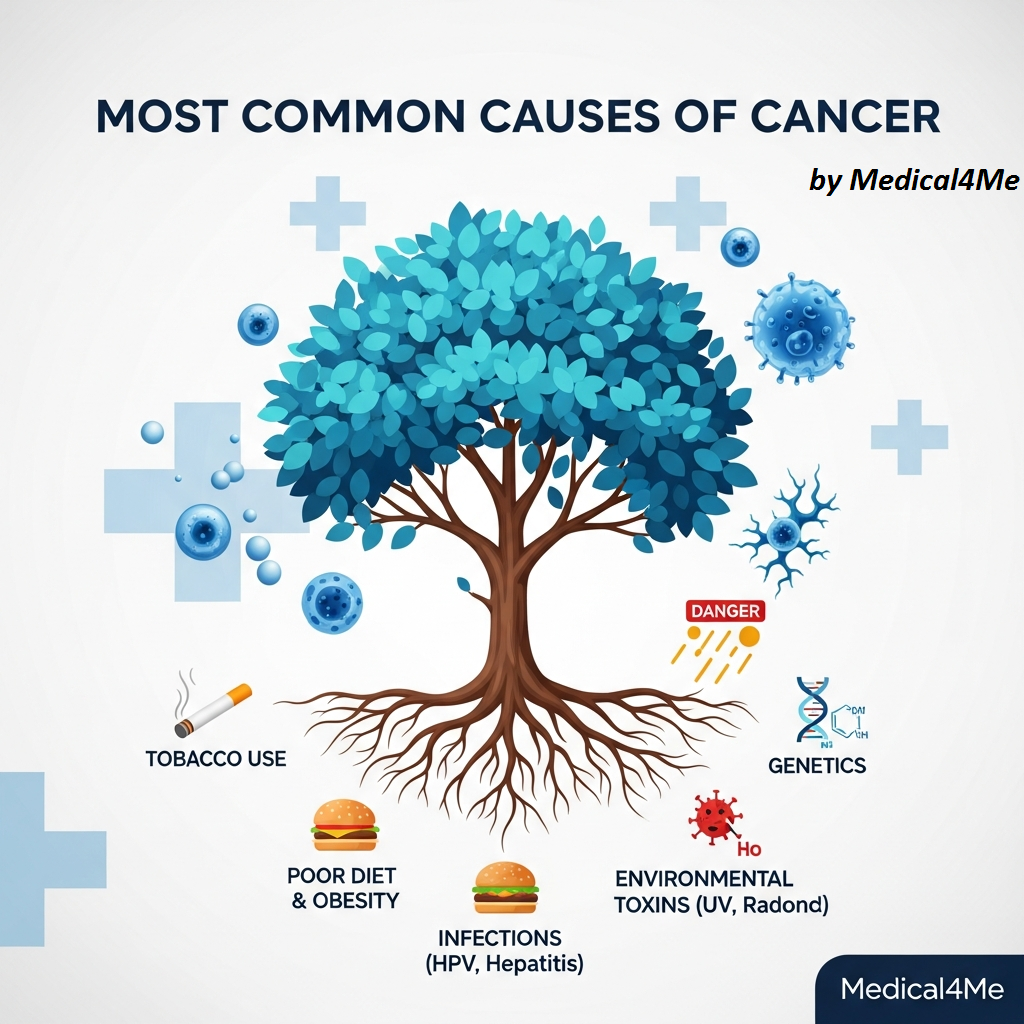Most Common Causes of Cancer: A Doctor’s Honest Guide

I still remember the Tuesday afternoon when Mr. Bilal walked into my clinic. A successful architect, Bilal was the kind of man who built skyscrapers but rarely checked his own foundation. “It’s just a cough, doc,” he said, waving a hand dismissively. “Probably some kind of allergies.”
It wasn’t allergies.
The diagnosis that followed—Stage 3 Lung Cancer—shattered the silence of the room. Bilal didn’t smoke, but he had spent thirty years working on construction sites inhaling dust and passive smoke. His story isn’t unique. In fact, nearly 40% of us will face a similar diagnosis at some point in our lives. That is a terrifying statistic, isn’t it?
But here’s the thing: fear grows in the dark. The moment we shine a light on the most common causes of cancer, the fear starts to shrink. Knowledge is the only weapon we have that actually works before the battle even begins.
I am writing this guide not as a textbook, but as a human being who has held too many hands in quiet rooms. We are going to talk about why this happens—to us, and surprisingly, to our beloved pets too. We will look at the environment, our genes, and the invisible triggers we ignore daily.
What Exactly Is Cancer?
Let’s strip away the medical jargon. Imagine your body is a massive, well-organized city. Every cell is a citizen with a specific job. They work, they age, and eventually, they retire (die) to make room for new citizens.
Cancer happens when one of these citizens goes rogue. Instead of retiring, this cell decides to stay. It starts cloning itself uncontrollably. It stops following the city’s traffic laws. These rogue cells form gangs (tumors) that crowd out the healthy workers, steal resources, and eventually try to take over the entire city.
It is not an invader from the outside; it is a rebellion from within.
The “Big Five”: Unmasking the Most Common Causes of Cancer
Patients often ask me, “Why me? Was it the stress? Was it the microwave?” While the internet is full of myths, science points to specific, proven culprits. Understanding these is your first line of defense.
1. The Smoke That Lingers (Tobacco)
I know, you’ve heard it a thousand times. But did you know that tobacco use is responsible for nearly 22% of all cancer deaths globally? It’s not just lung cancer. The carcinogens in smoke enter your bloodstream and travel everywhere—damaging your bladder, your throat, your pancreas, and your kidneys.
Even if you don’t smoke, secondhand smoke is a thief that steals health from those standing nearby. Mrs. Parveen, a lovely grandmother I met, never smoked a day in her life but lived with a chain-smoking husband for forty years. Her diagnosis was the same as his.
2. The Food We Fuel With (Diet & Obesity)
This is a hard conversation, especially in our culture where food is love. Biryani, nihari, deep-fried samosas—they are delicious, but they come at a cost. Excess body fat produces hormones and proteins that cause chronic inflammation. This inflammation acts like a slow-burning fire, eventually damaging DNA and leading to cancer.
Processed meats are another major issue. The World Health Organization classifies bacon, sausages, and hot dogs as Group 1 carcinogens—the same category as cigarettes. I’m not saying you can never have a hot dog again, but it shouldn’t be a daily staple.
3. The Invisible Enemies (Viruses and Infections)
It sounds strange to think you can “catch” cancer, doesn’t it? While cancer itself isn’t contagious, the viruses that cause it are. Hepatitis B and C can lead to liver cancer. Human Papillomavirus (HPV) is the primary cause of cervical cancer and many throat cancers.
The good news? We have vaccines. We can wipe out these causes before they ever get a foothold.
4. The Sun and the Soil (Environmental Exposure)
We love the sun. But ultraviolet (UV) rays are radiation. They smash into the DNA of your skin cells like tiny bullets. And it’s not just the sun. Radon gas—a radioactive gas that seeps up from the ground—is the second leading cause of lung cancer in the US.
5. The Hand We Were Dealt (Genetics)
Only about 5% to 10% of cancers are strictly hereditary. This means you inherited a broken gene from your parents, like the BRCA1 or BRCA2 gene. If your mother and aunt had breast cancer young, that’s a red flag. But remember: Genetics loads the gun, but lifestyle pulls the trigger. Even with bad genes, healthy living reduces your risk.
A Deep Dive: Explaining Every Major Type of Cancer
Cancer isn’t one disease. It’s a collection of over 100 related diseases. To fight it, we have to name it correctly. Doctors classify them based on where they start.
Carcinomas: The Most Common Culprits
These start in the skin or the tissues that line your internal organs. About 80% to 90% of cancers are carcinomas.
- Basal Cell Carcinoma: The most common form of skin cancer. It looks like a pearly bump. It rarely spreads but can be disfiguring if ignored.
- Squamous Cell Carcinoma: Also skin cancer, but can also form in the lining of the stomach, intestines, lungs, and bladder.
- Adenocarcinoma: This starts in the glands that produce fluids or mucus. Breast cancer, prostate cancer, and colon cancer often fall into this category.
Sarcomas: The Deep Tissue Invaders
These are rarer. They grow in the bones and soft tissues—muscle, fat, blood vessels, and fibrous tissues. Because they are deep, they often grow quite large before they are found.
- Osteosarcoma: The most common bone cancer. It’s heartbreakingly common in teenagers during growth spurts.
- Soft Tissue Sarcoma: Can happen anywhere but often found in the arms or legs.
Leukemias: The Liquid Cancers
These cancers don’t usually form solid tumors. They start in the bone marrow, which is the factory for blood cells. The factory breaks and starts pumping out millions of abnormal white blood cells that don’t work.
- Acute Lymphoblastic Leukemia (ALL): Most common in children. It progresses quickly and needs immediate treatment.
- Chronic Lymphocytic Leukemia (CLL): Affects older adults. It moves slowly; some patients live with it for years before needing treatment.
Lymphomas: The Immune System Saboteurs
These affect the lymphatic system, which is your body’s sewage treatment plant and security guard combined.
- Hodgkin Lymphoma: Identified by a specific cell called the Reed-Sternberg cell. It’s highly curable.
- Non-Hodgkin Lymphoma: A large group of diverse cancers. Some are slow, some are aggressive.
Central Nervous System Cancers
These start in the brain or spinal cord. They are distinct because they rarely spread outside the CNS, but even a small tumor here can cause massive problems due to the limited space in the skull.

The Connection Between Us and Them: Cancer in Animals
This is a topic close to my heart. We think of cancer as a uniquely human tragedy, but our pets—our silent, loyal companions—suffer from it too. In fact, studying cancer in animals is helping us cure it in humans. It’s a field called Comparative Oncology.
Cancer in Dogs vs. Humans
Dogs are surprisingly similar to us biologically. We eat the same food, drink the same water, and breathe the same air. That’s why dogs are often sentinels for environmental hazards.
Take Osteosarcoma (bone cancer). It looks almost identical under a microscope in a Golden Retriever and a teenage boy. The genetic errors driving the cancer are the same. Because dogs age faster, clinical trials in dogs give us answers in two years that would take fifteen years in humans. We are literally saving each other.
Lymphoma is another big one. In dogs, it is one of the most common cancers. The chemotherapy protocols we use for dogs (CHOP protocol) were originally designed for humans. And guess what? They work for both.
Cancer in Cats vs. Humans
Cats are a bit more mysterious. One of the most aggressive cancers in cats is Breast (Mammary) Cancer. In humans, about 80% of breast lumps are benign (harmless). In cats, 85% are malignant (cancerous) and aggressive. This teaches us about aggressive tumor biology.
Cats also get a cancer caused by a virus: Feline Leukemia Virus (FeLV). This is a direct parallel to virus-caused cancers in humans, like those caused by HPV or HIV. By studying vaccines for FeLV, we learn how to make better cancer vaccines for people.
Cancer in Birds vs. Humans
Even birds aren’t safe. Pet birds, specifically budgies and parakeets, are prone to Renal (Kidney) Tumors and testicular/ovarian tumors. Interestingly, because birds have such high metabolisms, their cancers grow incredibly fast. This helps researchers understand the “gas pedal” of cell growth.
The “One Health” Concept
If you smoke in your house, your cat is ingesting those toxins when it grooms its fur. Cats living with smokers have a significantly higher rate of oral cancer and lymphoma. Protecting your health protects theirs too.
Recognizing Symptoms: The Body’s Whisper
Cancer symptoms are sneaky. They often masquerade as common ailments. That back pain? Probably a strained muscle. That cough? Probably a cold. But knowing when to worry is key.
The Traffic Light System
- 🟢 Mild (Monitor): Fatigue that goes away with rest, temporary indigestion, a bruise that heals normally.
- 🟡 Moderate (Check it out): A cough that lasts more than 3 weeks, a new lump, a mole that changes shape, unexplained weight loss of 10 lbs or more.
- 🔴 Severe (Act Now): Coughing up blood, blood in urine or stool, a seizure, sudden inability to walk or speak.

The Diagnostic Journey
I know the word “biopsy” sounds terrifying. I sat with Mrs. Khan last month as she waited for hers. She was shaking. “They are going to cut me,” she whispered.
Here is what actually happens. It’s a step-by-step detective story.
- Imaging: We use CT scans, MRIs, or PET scans to take pictures inside the body. Think of it like using a satellite to look for a suspicious building.
- Biopsy: This is the only way to be 100% sure. We take a tiny sample of the tissue. We look at it under a microscope to see if the cells are “rogue.”
- Staging: If it is cancer, we need to know if it has spread. Stage 1 is local; Stage 4 means it has moved to other organs (metastasis).
- Genomic Testing: This is new and exciting. We analyze the DNA of the tumor itself. It tells us exactly which mutations are driving the bus, so we can shoot out the tires.
Treatment Options Comparison
Gone are the days when “chemo” was the only option. We have entered the era of precision medicine.
| Treatment | How It Works | Pros | Cons |
|---|---|---|---|
| Surgery | Physically cutting out the tumor. | Can be curative if cancer hasn’t spread. | Recovery time; risk of infection. |
| Chemotherapy | Drugs that kill fast-growing cells. | Attacks cancer everywhere in the body. | Kills healthy fast-growing cells too (hair, gut). |
| Radiation | High-energy beams to burn tumors. | Targeted to one area; saves organs. | Fatigue; skin burns; damage to nearby tissue. |
| Immunotherapy | Training your immune system to fight. | Less toxic; long-term protection. | Can cause autoimmune reactions; expensive. |

Prevention Strategies: Taking Control Back
You can’t control your genes, but you can control your dinner plate. You can control your environment. According to the American Cancer Society, at least 42% of newly diagnosed cancers are potentially avoidable.
- Daily: Eat something green. Move your body for 30 minutes. Wear sunscreen.
- Weekly: Limit alcohol. Alcohol is a known carcinogen. It turns into acetaldehyde, which damages DNA.
- Yearly: Get your screenings. Mammograms, colonoscopies, and Pap smears aren’t fun, but they catch cancer when it’s small and weak.
Learn more about building a resilient body in our guide on Explore Diseases.
Patient Story: Finding Hope in Stage 3
Let me tell you about Omar, a 35-year-old truck driver from Detroit. He was diagnosed with Stage 3 Colon Cancer. In our community, people often think Stage 3 is a death sentence. His family started mourning him while he was still sitting right there.
But Omar fought. He underwent surgery and six months of chemotherapy. It was brutal. There were days he couldn’t get out of bed. But he had a daughter, little Ayesha, and she needed her dad. Today, Omar is five years cancer-free. He drives his truck, he complains about the Detroit Lions, and he hugs Ayesha every single day. Cancer changes you, yes. But it doesn’t have to end you.
⚠️ When to Seek Medical Help
If you notice a change in your body that isn’t going away—a lump, a pain, a change in bowel habits—don’t just pray it away. Don’t just use home remedies. Go to a doctor. Early detection is the difference between a minor surgery and a fight for your life.
According to NIH, ignoring symptoms is the leading cause of late-stage diagnosis.
Latest Research & Developments (2024-2025)
The future is incredibly bright. In 2024, researchers at major institutes like Mayo Clinic began trials on mRNA cancer vaccines—using the same technology as the COVID vaccine to teach the body to hunt down cancer cells. We are also seeing AI being used to read mammograms with higher accuracy than human radiologists, finding tumors years before they can be felt.
Frequently Asked Questions
Conclusion
We have covered a lot of ground, haven’t we? From the most common causes of cancer like smoke and viruses to the complex biology of our cells and even the health of our pets. It’s a heavy topic.
But I want you to leave this page feeling empowered, not defeated. Mr. Bilal, who I mentioned at the start? He is still with us. He quit his job at the dusty construction site, started treatment, and is now designing eco-friendly, clean-air homes. He turned his pain into a purpose.
You have the power to lower your risk. You have the power to check your body. And if the unthinkable happens, you have the power to fight, armed with science and hope. For more on navigating complex diagnoses, read our guide on Medical4Me.com.
Take a deep breath. Go eat an apple. Go for a walk. Value this beautiful, complex machine that is your body.
Medical Disclaimer: This content is for informational purposes only and is not a substitute for professional medical advice, diagnosis, or treatment. Always seek the advice of your physician or other qualified health provider with any questions you may have regarding a medical condition. Never disregard professional medical advice or delay in seeking it because of something you have read on Medical4Me.com.

💬 Share Your Experience
Share your thoughts, questions, or personal tips below. Our community and editorial team value respectful and insightful discussions.